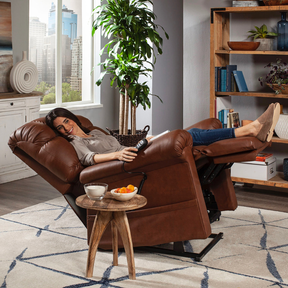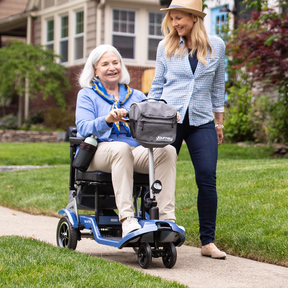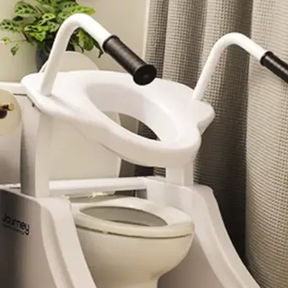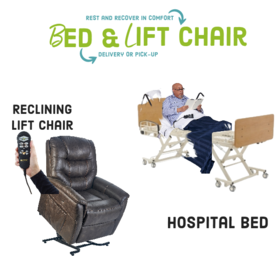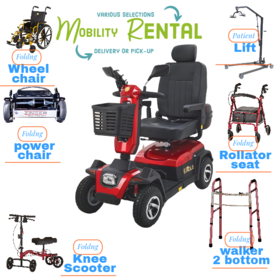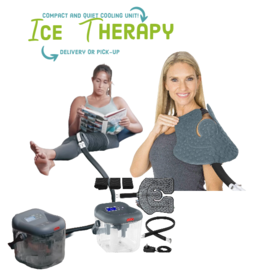Blog Mastering the Art of Utilizing a Transfer Gait Belt: An Easy way
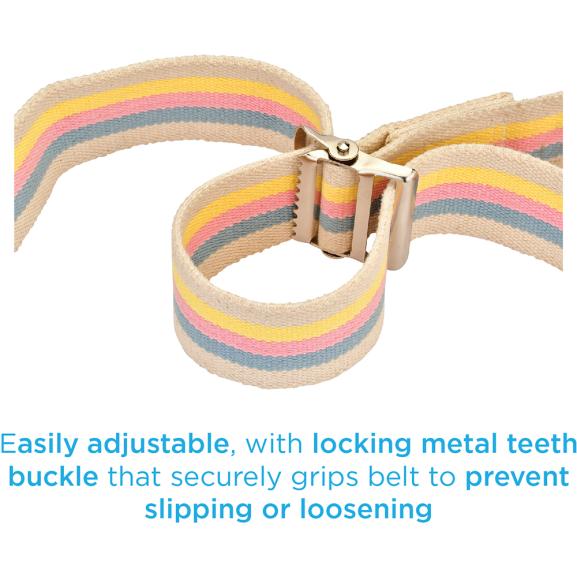
An assistive gait belt can be a helpful tool for caregivers and nurses who assist people with limited mobility. A gait belt provides stability for patients as they stand, sit, walk, or are transferred from one place to another by holding them around the waist. By evenly distributing a patient's weight instead of lifting someone freehand, gait belts reduce the chances of a fall, improve patient confidence, and prevent caregiver injuries. Learn about our recommendations for wearing gait belts properly in the following sections.
What is a Gait Belt?
Gait belts, sometimes called transfer belts, are safety devices caregivers use to assist patients with sitting, standing, and walking. A buckle is usually found on one end of these bags, which are made of a durable material like nylon, leather, or canvas.
There are many sizes and lengths of gait belts, but most are between 1.5 and 4 inches wide by 54-60 inches long. When fastened, there will likely be a lot of slack on the end, which allows gait belts to fit most patients. Some gait belts also include loops to make it easier for caregivers to grip them. In addition to increasing safety and security, a gait belt can enhance the transfer or walking of the patient.
will likely be a lot of slack on the end, which allows gait belts to fit most patients. Some gait belts also include loops to make it easier for caregivers to grip them. In addition to increasing safety and security, a gait belt can enhance the transfer or walking of the patient.
The gait belt prevents the patient from falling and controls the patient's balance. You also reduce your chances of hurting your back by wearing it.
The two most common types of gait belts are
Standard:
Typically, gait belts end with a metal buckle, which the belt is attached to by running it through grooves and loops.
Quick-Release:
Quick-release gait belts feature a simpler plastic buckle that snaps into place and can be secured and removed in seconds.
Steps to Use a Gait Belt?
The Occupational Safety and Health Administration (OSHA) recommends several best practices for using a gait belt. Ensure the belt is secure and snug — two fingers should fit between the belt and your patient — and not overly tight to prevent the resident from undoing it when moving. Ensure at least one layer of clothing between the gait belt and the resident's skin to avoid chafing. Be sure to remove any obstructions, such as bed rails or items on the floor, that might hamper movement.
If lifting the patient, count to the lift so you can rise simultaneously. Whatever you're doing with the gait belt, verbally inform the patient that you'll put it on them and walk them through the transfer process.
 It is essential to use gait belts properly to ensure patient safety and health. Follow these steps to ensure successful use:
It is essential to use gait belts properly to ensure patient safety and health. Follow these steps to ensure successful use:
- Remove any potential obstacles from the area and intended path.
- Explain to the patient what the gait belt will do and how it works so they are prepared.
- Align the buckle off-center on the patient's stomach and fasten the gait belt according to the steps described above for standard versus quick-release belts.
- For frailer or older patients, consider adding an extra layer of cloth to prevent chafing. Check your patient's clothing before tightening the belt. It will prevent chafing.
- Ensure there is enough room between the belt and the patient's body as you tighten the gait belt around the patient's waist.
- You must keep your back completely straight as you bend down using your knees and face the patient. You are at risk of injury if you don't use the proper form.
- The patient should be placed with two hands around their waist. Slide one hand under the belt and rest the other on the patient's back. The patient should be gripped underhanded, and the palm should face up instead of down.
- As you prepare to lift, it can be helpful to count down with the patient so they are ready to move smoothly with you. While you lift, maintain a firm grip on the belt with one hand and a steady presence on your back with the other.
Steps to Use a Gait Belt When Walking?
When patients are walking, a gait belt can also provide stability. Here are the tips you need to follow to make sure your gait belt works:
- If a patient falls or loses their balance, you should move behind them and to their side. If they have a weaker and stronger side, stand off to their weaker side.
- Using the same firm and underhanded method outlined previously, grip the gait belt firmly.
- It would be best to let the patient set the pace and maintain it behind them. Do not lead or pull them when they begin to walk.
- Make sure the patient keeps a firm grip on the gait belt if they begin to fall or lose their balance. While you guide them to the floor, use your off-center leg to gently brace their back as you show them to their feet. Your leg should be behind their back as you were in the off-center position.
Proper Body Mechanics
Keep your back straight while bending your knees to reduce the chances of hurting your back. When moving or lifting a patient, use your leg muscles instead of your back muscles. Tighten your abdominal muscles to protect your back. When moving or lifting, do not twist your body.
How to Determine Whether You Need a Transfer Belt?
It all depends on how severe your mobility limitations are. If you can't stand without help or are paralyzed in the legs, you'll need an easy-to-use transfer lift that doesn't require you to lift anything. Your caregiver may be able to assist you with a simple transfer board if you have enough balance and strength. Using a gait and transfer belt to stand and walk independently would be best.
Both the patient and caregiver will benefit from the use of this type of belt. Rather than grabbing onto someone in an awkward position, you can maintain good posture and body mechanics because the belt facilitates a better body position.
Final thoughts
Having a basic understanding of how to use a gait belt is an invaluable skill for you to possess. Follow the steps outlined above to assist your patients or loved ones with limited mobility.
Tags
- contest
- event
- supplies
- design
- brand
- video
- Compression
- upright walker
- four wheel walker
- rollator
- wheelchair
- Ostomy
- elegantly
- elegantly
- accessibility
- Mobility
- knee walker rental
- knee scooter sales
- knee scooter
- post operative shoe
- anti-embolic stockings
- pain management
- cryotherapy therapy
- hot cold compress
- compression stockings
- lift chair
- wound Care
- air purifier
- fall prevention
- cushion
- oxygen therapy
- cpap, bipap
- Hospital Bed
- Life Aide
- EMS
- recovery
- splint
- knee brace
- Bathroom
- patient lift
- medical supply
- Wound dressings
- Lightweight Wheelchair
- hospital beds for sale
- sky medical supplies rentals
- compression socks
- Adult Diapers
- Rollator Walker
- Bed Wedge Pillow
- Hospital beds
- Patient Lifts and Slings
- Portable Oxygen Concentrator
- Patient Lift Slings
- knee scooter rental
- folding mobility scooter
- mobility scooter
- medical shoes
- raised toilet seat
- hospital beds for rent
- lift chair recliner
- chair lift
- electric wheelchair
- Power Lift Recliners for Elderly
- Senior Walkers
- Bedside Commodes
- whill wheelchair
- compression hose
- Whill Electric Wheelchairs
- Bariatric Wheelchair
- Recliner Chairs with Lift
- Colostomy Bag
- Crutches
- Medical Wedge Pillow
- skin barrier tape
- Post Surgery Ice Machine
- Bedside Commode
- chair lift recliners
- cane holder scooter
- lift chair prices
- drop arm commode
- rollator walker with ergonomic seats
- Hospital Bed Rental
- Wheelchair Tray
- Golden Technologies Lift Chair
- Nova GetGo Junior Rollator
- power lift recliners
- Knee Scooters and Crutches:
- stand up walker for seniors
- stand up walker as seen on TV
- Women's Walking Canes
- Knee Immobilizers
- Bed Wedge Pillow
- Medical Supply Stores
- Sit to Stand Lifts
- Grab Bars
- Compression Gloves
- incontinence bed pads
- Lift Reclining Chair
- Knee Walker Scooters
- Hernia Belt Near You
- Mobility Scooter Stores Near Me
- Folding Knee Walker
- Oxygen Concentrator Store
- Inogen Battery
- Electric Bed Frames
- Placing Lift Chair
- diaper brief
Related Posts
Get weekly articles in your inbox on the latest medical supply news, exclusive deals, and helpful health tips.
